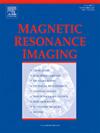弥散基谱成像检测外伤性脑损伤后视神经轴突损伤。
IF 2
4区 医学
Q2 RADIOLOGY, NUCLEAR MEDICINE & MEDICAL IMAGING
引用次数: 0
摘要
目的:利用弥散基谱成像(DBSI),一种先进的成像方式,已被证明可以区分共同发生的白质病变,以识别外伤性脑损伤(TBI)患者视神经的变化。方法:前瞻性招募7例TBI患者,在损伤后2个月内进行3 T磁共振成像脑扫描,并在6个月和12个月进行随访扫描。视神经被认为是感兴趣的区域。手动对齐视神经切片,随后部署内部脚本获取后处理数据。扩散张量成像和dbsi衍生的轴向(AD)和径向扩散率(RD),分别反映轴突和髓鞘的完整性进行比较。dbsi衍生的信号强度也进行了比较。进行Kruskal-Wallis检验以确定显著性(p )结果:患者的14条视神经与对照患者的18条视神经进行比较。DTI RD值在患者中显著高于对照组(p )结论:dbsi源性AD的急性减少和纤维组分的持续减少可以作为TBI患者视神经轴突损伤的潜在生物标志物。本文章由计算机程序翻译,如有差异,请以英文原文为准。
Diffusion basis spectrum imaging detects axonal injury in the optic nerve following traumatic brain injury
Purpose
To utilize diffusion basis spectrum imaging (DBSI), an advanced imaging modality that has been shown to distinguish between co-occurring white matter pathologies, to discern changes in the optic nerves among patients with traumatic brain injury (TBI).
Methods
Seven patients with TBI were prospectively recruited to undergo a 3 T magnetic resonance imaging brain scan within two months of injury, and follow-up scans at 6- and 12-months. The optic nerve was considered the region of interest. Manual alignment of the optic nerve slices was performed, followed by the deployment of an in-house script to obtain post-processed data. Diffusion tensor imaging and DBSI-derived axial (AD) and radial diffusivity (RD), reflecting axon and myelin integrity, respectively, were compared. DBSI-derived signal intensities were also compared. The Kruskal-Wallis test was performed to determine significance (p < 0.05).
Results
Fourteen optic nerves from patients were compared with 18 optic nerves from control participants. The values of DTI RD were significantly greater among patients than controls (p < 0.05) across all timepoints, with no corresponding differences in the AD. However, a decrease in DBSI AD (p < 0.01) observed only at the initial scan, coupled with a stable RD, was observed among patients. Comparisons between DBSI signal intensities among patients showed no appreciable differences; however, the fiber fraction was significantly lower (p < 0.05) at all timepoints.
Conclusion
Acute reductions in DBSI-derived AD and sustained reductions in fiber fraction can serve as a potential biomarker for axonal injury in the optic nerves of patients with TBI.
求助全文
通过发布文献求助,成功后即可免费获取论文全文。
去求助
来源期刊

Magnetic resonance imaging
医学-核医学
CiteScore
4.70
自引率
4.00%
发文量
194
审稿时长
83 days
期刊介绍:
Magnetic Resonance Imaging (MRI) is the first international multidisciplinary journal encompassing physical, life, and clinical science investigations as they relate to the development and use of magnetic resonance imaging. MRI is dedicated to both basic research, technological innovation and applications, providing a single forum for communication among radiologists, physicists, chemists, biochemists, biologists, engineers, internists, pathologists, physiologists, computer scientists, and mathematicians.
 求助内容:
求助内容: 应助结果提醒方式:
应助结果提醒方式:


